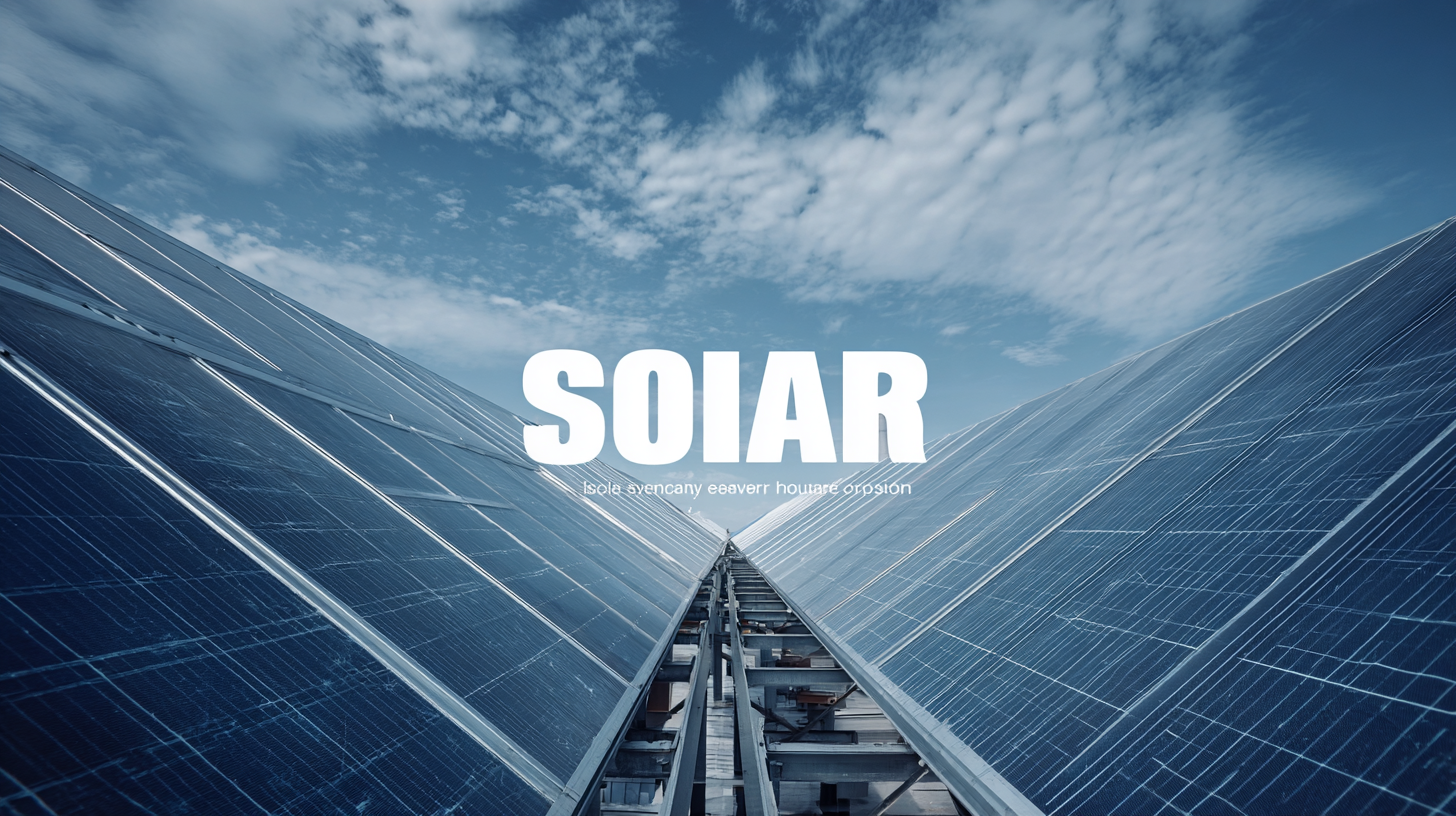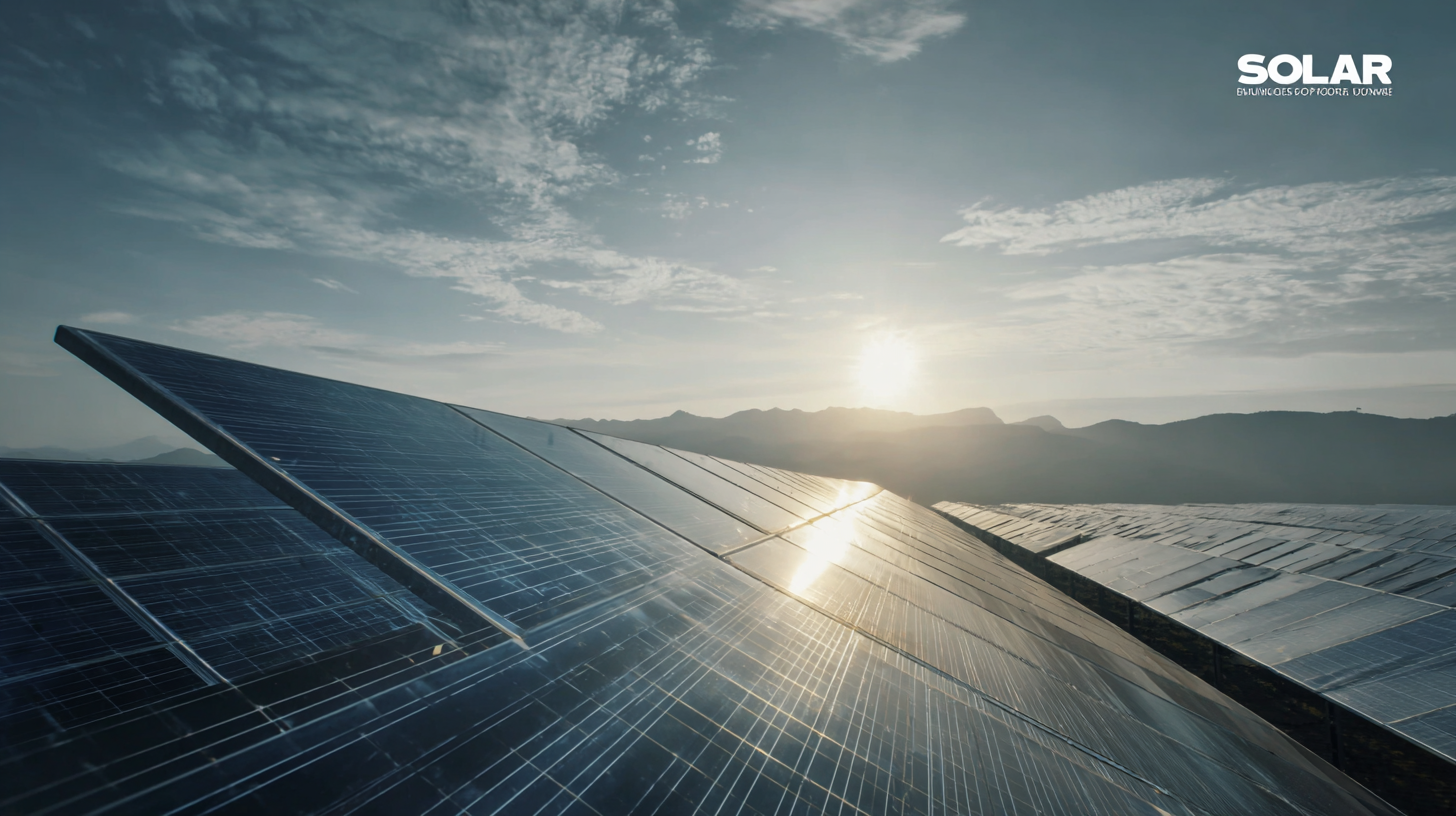Discover the Finest Solar Energy Solutions from China’s Leading Manufacturing Experts
The global push for renewable energy has increasingly highlighted the significance of Solar Energy, particularly as countries strive to meet ambitious climate goals. According to the International Energy Agency (IEA), solar power capacity could rise to 4,800 GW by 2030, representing nearly one-third of the world’s electricity needs. As a pioneer in solar technology, China dominates the manufacturing sector, supplying more than 70% of solar panels worldwide, according to the Solar Energy Industries Association (SEIA). This blog explores the finest solar energy solutions provided by China’s leading manufacturing experts, who are not only advancing technological innovations but also contributing significantly to global sustainability efforts. With a combination of expertise and cutting-edge technology, these manufacturers are setting the standard for Solar Energy production, driving a crucial transition towards a cleaner and greener energy future.

Key Characteristics of Monocrystalline Solar Panels and Their Ideal Applications
Monocrystalline solar panels have gained significant traction in the renewable energy market due to their high efficiency and space-saving characteristics. According to a report by the International Renewable Energy Agency (IRENA), monocrystalline panels can achieve efficiency rates of 15% to 22%, making them one of the most efficient solar technologies available today. Their unique manufacturing process, involving the use of pure silicon, allows them to outperform their polycrystalline counterparts, particularly in low-light conditions. This efficiency makes them ideal for residential installations where roof space is limited.
In addition to their efficiency, monocrystalline panels also exhibit superior performance in terms of longevity and durability. Reports from the U.S. Department of Energy indicate that these panels have a lifespan of 25 years or more, often accompanied by extensive warranties. This reliability renders monocrystalline solar panels an excellent choice for commercial applications, such as large-scale solar farms where long-term energy generation is critical. Furthermore, their sleek design and darker color aesthetics appeal to consumers who prioritize both performance and visual appeal in solar technology.
Understanding Polycrystalline Solar Panels: Features and Best Use Cases
Polycrystalline solar panels are an excellent choice for those looking to harness solar energy efficiently and cost-effectively. These panels are created by melting multiple silicon crystals together, resulting in a blue, speckled appearance that distinguishes them from their monocrystalline counterparts. One of the primary advantages of polycrystalline panels is their affordability, making them suitable for both residential and commercial applications without breaking the bank. Furthermore, they perform exceptionally well in moderate temperatures, making them ideal for regions with fluctuating weather conditions.
When considering polycrystalline solar panels, it's vital to assess the specific energy needs and geographical location. For instance, homes in areas with frequent sunny days will benefit significantly from the efficiency of these panels. Here’s a tip: ensure that your roof has sufficient space and is oriented correctly to maximize sunlight exposure. Additionally, pairing polycrystalline panels with a quality inverter system can enhance their efficiency and extend their lifespan.
Another important consideration is the warranty and durability of the panels. Many leading manufacturers provide warranties ranging from 10 to 25 years, reflecting their confidence in product longevity. It's beneficial to choose brands with a proven track record and strong customer reviews. Remember to check for certifications, as they can indicate quality and reliability while helping you make an informed decision.
Understanding Polycrystalline Solar Panels: Efficiency and Applications
This chart illustrates the conversion efficiency and optimal use cases of polycrystalline solar panels based on different environments and applications.
Innovative Bifacial Solar Technology: Advantages and Target Markets
Innovative bifacial solar technology is transforming the renewable energy landscape by maximizing efficiency and energy output. Unlike traditional solar panels, bifacial models capture sunlight on both sides, allowing them to generate more power from reflected sunlight. This unique feature makes them particularly effective in areas with high albedo, such as snowy or sandy terrains, where light is reflected back onto the panels. As a result, these advanced systems can boost energy production significantly, providing an appealing cost-benefit analysis for both enterprise and residential sectors.
Target markets for bifacial solar technology are rapidly expanding, driven by the increasing global demand for sustainable energy sources. Regions with abundant sunlight and reflective surfaces stand to benefit the most, including various parts of Asia, North America, and Europe. Additionally, industries looking to enhance their sustainability practices are increasingly adopting this technology. With the ongoing advancements in manufacturing processes and materials, solar energy solutions from China's leading manufacturers are becoming more accessible, paving the way for a greener future and greater energy independence.
Discover the Finest Solar Energy Solutions from China’s Leading Manufacturing Experts - Innovative Bifacial Solar Technology: Advantages and Target Markets
| Feature | Description | Target Market | Efficiency |
|---|---|---|---|
| Bifacial Technology | Utilizes both sides of the panel to capture sunlight | Residential, Commercial | Up to 25% more efficient than traditional panels |
| Durability | High resistance to extreme weather conditions | Utility-scale, Agricultural | 25-year warranty on performance |
| Cost-effectiveness | Lower LCOE due to higher energy yield | Energy Storage Solutions | 15-20% reduction in overall costs |
| Environmental Impact | Significantly lowers carbon footprint | Commercial Buildings, Factories | Promotes sustainability |
| Scalability | Easily adjustable for various sizes and capacities | Residential, Large Industrial | Flexible configurations available |
Exploring Thin-Film Solar Solutions: Pros, Cons, and Suitable Environments
As the world increasingly turns towards renewable energy, thin-film solar technology has emerged as a promising alternative in the solar energy landscape. Thin-film solar panels are known for their lightweight and flexible design, making them suitable for a variety of applications where traditional silicon panels may not be feasible. This adaptability offers significant advantages, especially in challenging environments where installation flexibility is crucial.

However, despite their benefits, thin-film solar solutions come with their own set of drawbacks. One major disadvantage is their lower efficiency compared to crystalline silicon panels, meaning that more surface area is required to generate the same amount of power. Additionally, the manufacturing processes for some thin-film technologies can involve hazardous materials, raising environmental and safety concerns.
As such, while they may be suitable for certain environments like rooftops with limited space or integrated into building materials, careful consideration must be given to their overall performance and impact in relation to the project's specific needs.
Comparative Analysis of Solar Inverters: Types and Best Fit for Your Energy Needs
 When considering solar energy solutions, understanding the types and suitability of solar inverters is essential for maximizing efficiency and cost-effectiveness. Solar inverters are the heart of any grid-connected photovoltaic system, converting the direct current (DC) generated by solar panels into alternating current (AC) for home use. Each type of inverter has its own advantages and may suit different energy needs, from string inverters for smaller setups to microinverters for larger, more complex systems.
When considering solar energy solutions, understanding the types and suitability of solar inverters is essential for maximizing efficiency and cost-effectiveness. Solar inverters are the heart of any grid-connected photovoltaic system, converting the direct current (DC) generated by solar panels into alternating current (AC) for home use. Each type of inverter has its own advantages and may suit different energy needs, from string inverters for smaller setups to microinverters for larger, more complex systems.
*Tips: When selecting a solar inverter, consider the size and layout of your solar array, as well as your energy consumption patterns. A good inverter should match your system's specifications and provide efficient power conversion for your specific needs.*
In addition to choosing the right inverter, a comparative analysis of solar panel systems, such as the Tesla Solar Roof versus traditional solar panels, is vital. Factors to evaluate include price, overall value, efficiency ratings, and aesthetics. The right system should not only be cost-effective but also complement your home’s design and provide reliable energy output.
*Tips: Before making a decision, gather multiple quotes and research customer reviews of different solar solutions to ensure you choose a system that aligns with your expectations and budget.*


